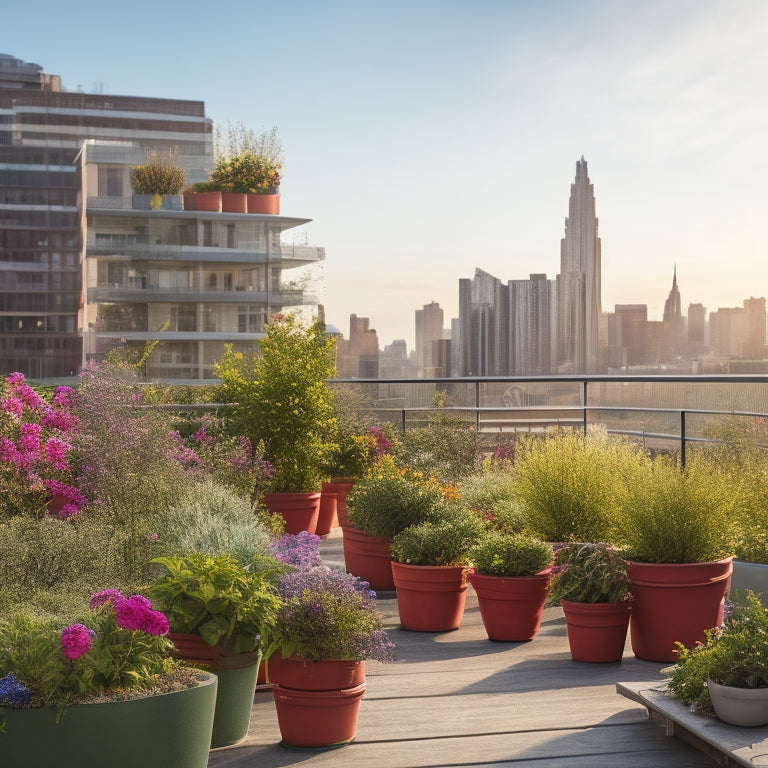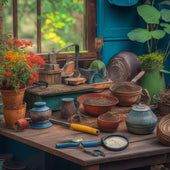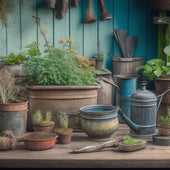
5 Tips for Rooftop Gardening With Vertical Planters
Share
When creating a rooftop garden with vertical planters, you'll want to choose planters that fit your rooftop's weight capacity and plant size, and select durable materials for longevity. Select plants that can tolerate full sun to partial shade and prioritize wind-resistant varieties. Maximize space with tiered designs, using shorter planters in front and taller ones in back. Regularly inspect soil moisture, temperature, and plant health, and prune plants to maintain shape and promote growth. By following these tips, you'll be well on your way to a thriving rooftop oasis - and there's even more to explore when it comes to overcoming unique rooftop gardening challenges.
Key Takeaways
• Select a vertical planter that fits your rooftop's weight capacity and plant size, with durable materials for longevity.
• Choose wind-resistant plants with sturdy stems and compact growth, tolerant of full sun to partial shade, for rooftop conditions.
• Utilize tiered designs to maximize vertical space, arranging planters in staggered formation for depth and visual appeal.
• Ensure proper drainage and irrigation systems in your vertical planter to prevent water logging and promote healthy plant growth.
• Regularly inspect soil moisture, temperature, and plant health, and prune plants to maintain shape and promote growth.
Choose the Right Vertical Planter
Select a vertical planter that fits your rooftop's weight capacity and accommodates the mature size of your plants, considering factors like material, drainage, and irrigation systems.
You'll want to guarantee the planter can support the weight of the soil, plants, and water. Materials selection is essential, as it affects the planter's durability, maintenance, and overall aesthetic. You can choose from a range of materials, including plastic, metal, wood, or composite materials. Each has its pros and cons, so consider factors like weather resistance, rust, and rot.
Regarding planter styles, you've got options like trellis, wall-mounted, or freestanding planters. Trellis planters provide structural support for climbing plants, while wall-mounted planters save space and add a decorative touch. Freestanding planters offer flexibility with placement and arrangement.
Consider the style that best suits your rooftop's layout and your personal preferences. By choosing the right vertical planter, you'll set yourself up for success and create a thriving rooftop garden that meets your needs and exceeds your expectations.
Selecting Plants for Rooftop Conditions
With your vertical planter in place, you're ready to populate it with plants that'll not only thrive in rooftop conditions but also provide the desired aesthetic and functionality for your outdoor space.
When selecting plants, consider the rooftop's unique conditions, such as intense sun exposure and strong winds. Choose plants that are tolerant of full sun to partial shade, depending on your rooftop's orientation and the amount of shade provided by surrounding structures.
Wind resistance is also vital, as strong gusts can damage plants and planters. Look for plants with sturdy stems, compact growth habits, and small leaves that can withstand wind stress.
Succulents, grasses, and herbs are excellent choices for rooftop gardens, as they're adapted to harsh conditions and require minimal maintenance. Additionally, consider plants with shallow root systems, which are better suited for vertical planters with limited soil depth.
Maximizing Space With Tiered Designs
By incorporating tiered designs into your rooftop garden, you can reveal hidden vertical space and create a visually striking display that maximizes every square inch of your planter. This approach to space efficiency is particularly effective in rooftop gardens, where square footage is often limited. Tiered aesthetics not only add visual interest but also enable you to grow a variety of plants in a compact area.
To create a tiered design, start by selecting planters of varying heights and widths. You can then arrange them in a staggered formation, with shorter planters in front and taller ones in back. This will create a sense of depth and visual appeal.
Consider using a combination of shallow and deep planters to accommodate different types of plants. For example, shallow planters are ideal for succulents and herbs, while deeper planters can support larger plants like tomatoes and peppers.
Proper Care and Maintenance Tips
Regularly inspecting your rooftop garden's soil moisture, temperature, and plant health will help you catch potential issues before they escalate into major problems. This proactive approach allows you to address minor issues before they become major headaches.
When it comes to watering, it's crucial to employ effective watering techniques that don't waste water or over-saturate the soil. You'll want to water your plants in the morning, so the plants have the entire day to absorb the water.
Here are some additional care and maintenance tips to keep in mind:
-
Monitor for pests: Regularly inspect your plants for signs of pests, such as aphids, whiteflies, or spider mites. Catching infestations early can prevent significant damage to your plants.
-
Fertilize wisely: Use a balanced fertilizer that's specifically formulated for rooftop gardens. Avoid over-fertilizing, as this can damage your plants and contaminate nearby water sources.
-
Prune regularly: Prune your plants to maintain their shape, promote healthy growth, and encourage blooming. This will also help prevent disease and pest issues.
Overcoming Rooftop Gardening Challenges
As you venture into rooftop gardening, you'll inevitably encounter challenges that can make or break your green oasis, and being prepared to tackle them head-on is vital to success. From harsh weather conditions to pesky pests, it's important to anticipate and address these obstacles to guarantee your vertical planters thrive.
Here are some common challenges and solutions to reflect on:
| Challenge | Solution | Tips |
|---|---|---|
| Weather Considerations | Use wind-resistant planters | Secure plants with stakes or ties |
| Pest Management | Install physical barriers | Use organic pest control methods |
| Water Logging | Guarantee proper drainage | Add a layer of perlite or vermiculite |
| Limited Space | Opt for compact plants | Use trellises or obelisks for support |
| Soil Erosion | Mulch around plants | Use a soil stabilizer to prevent erosion |
Frequently Asked Questions
Can I Use Vertical Planters on a Balcony With a Small Footprint?
You can maximize your balcony's small footprint by choosing compact vertical planters that optimize space while enhancing aesthetics, ensuring a beautiful and functional outdoor area that meets your needs for control and design.
How Do I Secure Planters From Strong Rooftop Winds?
"You're not going to let 100-mph winds turn your rooftop oasis into a plant-filled tornado, are you? Use wind-resistant materials and master planter anchoring techniques, like weighted bases and securing straps, to keep your vertical planters firmly in place."
Are Vertical Planters Suitable for Growing Vegetables and Fruits?
You'll find that vertical planters are well-suited for growing a variety of vegetables, such as leafy greens, cherry tomatoes, and cucumbers, thanks to their space-saving design and benefits like increased yields and reduced water usage.
Can I Use a Trellis to Support Climbing Plants in Vertical Planters?
"Don't worry, you won't be limited by weak trellis materials! You can choose sturdy options like metal or wooden trellises to support your climbing plants. Select vining varieties like peas, cucumbers, or tomatoes that thrive in vertical planters."
Do Rooftop Gardens Attract Pests or Rodents?
You'll want to prioritize pest control and rodent prevention in your rooftop garden, as the elevated environment can attract unwanted visitors; implement integrated pest management strategies and rodent-deterrent measures to protect your plants.
Related Posts
-

5 Must-Knows for Buying Used Tools for Planters
When buying used tools for planters, you're investing in the reliability and performance of your operations, so it's ...
-

5 Must-Knows for Buying Used Tools for Planters
When buying used tools for planters, you're investing in the reliability and performance of your operations, so it's ...
-

5 Must-Knows for Buying Used Tools for Planters
When buying used tools for planters, you're investing in the reliability and performance of your operations, so it's ...
-

5 Must-Knows for Buying Used Tools for Planters
When buying used tools for planters, you're investing in the reliability and performance of your operations, so it's ...
-

5 Must-Knows for Buying Used Tools for Planters
When buying used tools for planters, you're investing in the reliability and performance of your operations, so it's ...
-

5 Must-Knows for Buying Used Tools for Planters
When buying used tools for planters, you're investing in the reliability and performance of your operations, so it's ...
-

5 Must-Knows for Buying Used Tools for Planters
When buying used tools for planters, you're investing in the reliability and performance of your operations, so it's ...
-

5 Must-Knows for Buying Used Tools for Planters
When buying used tools for planters, you're investing in the reliability and performance of your operations, so it's ...
-

5 Must-Knows for Buying Used Tools for Planters
When buying used tools for planters, you're investing in the reliability and performance of your operations, so it's ...
-

5 Must-Knows for Buying Used Tools for Planters
When buying used tools for planters, you're investing in the reliability and performance of your operations, so it's ...
-

5 Must-Knows for Buying Used Tools for Planters
When buying used tools for planters, you're investing in the reliability and performance of your operations, so it's ...
-

5 Must-Knows for Buying Used Tools for Planters
When buying used tools for planters, you're investing in the reliability and performance of your operations, so it's ...
-

5 Must-Knows for Buying Used Tools for Planters
When buying used tools for planters, you're investing in the reliability and performance of your operations, so it's ...
-

5 Must-Knows for Buying Used Tools for Planters
When buying used tools for planters, you're investing in the reliability and performance of your operations, so it's ...
-

5 Must-Knows for Buying Used Tools for Planters
When buying used tools for planters, you're investing in the reliability and performance of your operations, so it's ...
-

5 Must-Knows for Buying Used Tools for Planters
When buying used tools for planters, you're investing in the reliability and performance of your operations, so it's ...
-

5 Must-Knows for Buying Used Tools for Planters
When buying used tools for planters, you're investing in the reliability and performance of your operations, so it's ...
-

5 Must-Knows for Buying Used Tools for Planters
When buying used tools for planters, you're investing in the reliability and performance of your operations, so it's ...
-

5 Must-Knows for Buying Used Tools for Planters
When buying used tools for planters, you're investing in the reliability and performance of your operations, so it's ...
-

5 Must-Knows for Buying Used Tools for Planters
When buying used tools for planters, you're investing in the reliability and performance of your operations, so it's ...
-

How Much Do Concrete Planters Weigh
When creating a concrete planter, you'll need to take into account the weight implications of your design. The type a...
-

How Much Do Concrete Planters Weigh
When creating a concrete planter, you'll need to take into account the weight implications of your design. The type a...
-

How Much Do Concrete Planters Weigh
When creating a concrete planter, you'll need to take into account the weight implications of your design. The type a...
-

How Much Do Concrete Planters Weigh
When creating a concrete planter, you'll need to take into account the weight implications of your design. The type a...
-

How Much Do Concrete Planters Weigh
When creating a concrete planter, you'll need to take into account the weight implications of your design. The type a...
-

How Much Do Concrete Planters Weigh
When creating a concrete planter, you'll need to take into account the weight implications of your design. The type a...
-

How Much Do Concrete Planters Weigh
When creating a concrete planter, you'll need to take into account the weight implications of your design. The type a...
-

How Much Do Concrete Planters Weigh
When creating a concrete planter, you'll need to take into account the weight implications of your design. The type a...
-

How Much Do Concrete Planters Weigh
When creating a concrete planter, you'll need to take into account the weight implications of your design. The type a...
-

How Much Do Concrete Planters Weigh
When creating a concrete planter, you'll need to take into account the weight implications of your design. The type a...
-

How Much Do Concrete Planters Weigh
When creating a concrete planter, you'll need to take into account the weight implications of your design. The type a...
-

How Much Do Concrete Planters Weigh
When creating a concrete planter, you'll need to take into account the weight implications of your design. The type a...
-

How Much Do Concrete Planters Weigh
When creating a concrete planter, you'll need to take into account the weight implications of your design. The type a...
-

How Much Do Concrete Planters Weigh
When creating a concrete planter, you'll need to take into account the weight implications of your design. The type a...
-

How Much Do Concrete Planters Weigh
When creating a concrete planter, you'll need to take into account the weight implications of your design. The type a...
-

How Much Do Concrete Planters Weigh
When creating a concrete planter, you'll need to take into account the weight implications of your design. The type a...
-

How Much Do Concrete Planters Weigh
When creating a concrete planter, you'll need to take into account the weight implications of your design. The type a...
-

How Much Do Concrete Planters Weigh
When creating a concrete planter, you'll need to take into account the weight implications of your design. The type a...
-

How Much Do Concrete Planters Weigh
When creating a concrete planter, you'll need to take into account the weight implications of your design. The type a...
-

How Much Do Concrete Planters Weigh
When creating a concrete planter, you'll need to take into account the weight implications of your design. The type a...
-

How Much Do Concrete Planters Weigh
When creating a concrete planter, you'll need to take into account the weight implications of your design. The type a...
-

How Much Do Concrete Planters Weigh
When creating a concrete planter, you'll need to take into account the weight implications of your design. The type a...
-

How Much Do Concrete Planters Weigh
When creating a concrete planter, you'll need to take into account the weight implications of your design. The type a...
-

How Much Do Concrete Planters Weigh
When creating a concrete planter, you'll need to take into account the weight implications of your design. The type a...
-

How Much Do Concrete Planters Weigh
When creating a concrete planter, you'll need to take into account the weight implications of your design. The type a...
-

How Much Do Concrete Planters Weigh
When creating a concrete planter, you'll need to take into account the weight implications of your design. The type a...
-

How Much Do Concrete Planters Weigh
When creating a concrete planter, you'll need to take into account the weight implications of your design. The type a...
-

How Much Do Concrete Planters Weigh
When creating a concrete planter, you'll need to take into account the weight implications of your design. The type a...
-

How Much Do Concrete Planters Weigh
When creating a concrete planter, you'll need to take into account the weight implications of your design. The type a...
-

Inspect and Revive Second-Hand Tools for Planters
When inspecting and reviving second-hand tools for planters, prioritize tools with sturdy builds and functional parts...
-

Inspect and Revive Second-Hand Tools for Planters
When inspecting and reviving second-hand tools for planters, prioritize tools with sturdy builds and functional parts...
-

Inspect and Revive Second-Hand Tools for Planters
When inspecting and reviving second-hand tools for planters, prioritize tools with sturdy builds and functional parts...
-

Inspect and Revive Second-Hand Tools for Planters
When inspecting and reviving second-hand tools for planters, prioritize tools with sturdy builds and functional parts...
-

Inspect and Revive Second-Hand Tools for Planters
When inspecting and reviving second-hand tools for planters, prioritize tools with sturdy builds and functional parts...
-

Inspect and Revive Second-Hand Tools for Planters
When inspecting and reviving second-hand tools for planters, prioritize tools with sturdy builds and functional parts...
-

Inspect and Revive Second-Hand Tools for Planters
When inspecting and reviving second-hand tools for planters, prioritize tools with sturdy builds and functional parts...
-

Inspect and Revive Second-Hand Tools for Planters
When inspecting and reviving second-hand tools for planters, prioritize tools with sturdy builds and functional parts...
-

Inspect and Revive Second-Hand Tools for Planters
When inspecting and reviving second-hand tools for planters, prioritize tools with sturdy builds and functional parts...
-

Inspect and Revive Second-Hand Tools for Planters
When inspecting and reviving second-hand tools for planters, prioritize tools with sturdy builds and functional parts...
-

Inspect and Revive Second-Hand Tools for Planters
When inspecting and reviving second-hand tools for planters, prioritize tools with sturdy builds and functional parts...
-

Inspect and Revive Second-Hand Tools for Planters
When inspecting and reviving second-hand tools for planters, prioritize tools with sturdy builds and functional parts...
-

Inspect and Revive Second-Hand Tools for Planters
When inspecting and reviving second-hand tools for planters, prioritize tools with sturdy builds and functional parts...
-

Inspect and Revive Second-Hand Tools for Planters
When inspecting and reviving second-hand tools for planters, prioritize tools with sturdy builds and functional parts...
-

Inspect and Revive Second-Hand Tools for Planters
When inspecting and reviving second-hand tools for planters, prioritize tools with sturdy builds and functional parts...
-

Inspect and Revive Second-Hand Tools for Planters
When inspecting and reviving second-hand tools for planters, prioritize tools with sturdy builds and functional parts...
-

Inspect and Revive Second-Hand Tools for Planters
When inspecting and reviving second-hand tools for planters, prioritize tools with sturdy builds and functional parts...
-

Inspect and Revive Second-Hand Tools for Planters
When inspecting and reviving second-hand tools for planters, prioritize tools with sturdy builds and functional parts...
-

Inspect and Revive Second-Hand Tools for Planters
When inspecting and reviving second-hand tools for planters, prioritize tools with sturdy builds and functional parts...
-

Inspect and Revive Second-Hand Tools for Planters
When inspecting and reviving second-hand tools for planters, prioritize tools with sturdy builds and functional parts...
-

Inspect and Revive Second-Hand Tools for Planters
When inspecting and reviving second-hand tools for planters, prioritize tools with sturdy builds and functional parts...
-

Inspect and Revive Second-Hand Tools for Planters
When inspecting and reviving second-hand tools for planters, prioritize tools with sturdy builds and functional parts...
-

Inspect and Revive Second-Hand Tools for Planters
When inspecting and reviving second-hand tools for planters, prioritize tools with sturdy builds and functional parts...
-

Inspect and Revive Second-Hand Tools for Planters
When inspecting and reviving second-hand tools for planters, prioritize tools with sturdy builds and functional parts...
-

Inspect and Revive Second-Hand Tools for Planters
When inspecting and reviving second-hand tools for planters, prioritize tools with sturdy builds and functional parts...
-

Inspect and Revive Second-Hand Tools for Planters
When inspecting and reviving second-hand tools for planters, prioritize tools with sturdy builds and functional parts...


